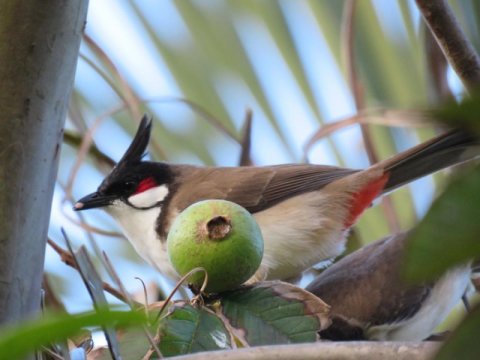[ad_1]
On the Hawaiian island of Oahu, it is possible to stand in a lush tropical forest that doesn’t contain a single native plant. The birds that once dispersed native seeds are almost entirely gone too, leaving a brand-new ecological community composed of introduced plants and birds. In a first-of-its-kind study published today in Science, researchers demonstrate that these novel communities are organized in much the same way as native communities worldwide.
The discovery comes after an exhaustive examination of bird diets across Oahu and a subsequent network analysis describing bird-plant interactions on the island. Unexpectedly, the analysis showed introduced birds have developed complex patterns of interactions with plants, most of them non-native to the island. And when bird-plant interactions in Oahu were compared to native-dominated ecosystems around the world, they were strikingly similar.
“These birds on Oahu aren’t interacting with these invasive plants randomly. They’re actually selecting certain plants. What’s interesting about this is that these birds didn’t co-evolve with these plants. We think of specialization as a co-evolved trait that develops over millennia, but we are seeing it in completely novel ecosystems and in species that have only lived together for less than 100 years,” says Jinelle Sperry, wildlife biologist for the U.S. Army Engineer Research and Development Center, adjunct professor in the Department of Natural Resources and Environmental Sciences (NRES) at the University of Illinois, and co-author on the Science study.
The researchers also tested the stability of these bird-plant interactions by simulating the extinction of plant species. That result was surprising, as well.
“We were trying to determine how fast the birds would go extinct if you remove plants in a given sequence. I simulated this for Oahu and native-dominated communities and compared,” says Jeferson Vizentin-Bugoni, lead author on the study and postdoctoral researcher with the U.S. Army Engineer Research and Development Center and NRES at U of I. “The rates at which Oahu communities collapsed in the simulations were very similar to native communities. This means that now these novel networks in Hawaii are as stable as native-dominated communities.”
Although the results could be interpreted as a silver lining to the ever-increasing threat of invasive species and extinctions, the researchers call for caution. First, there’s the fact that they didn’t find evidence of a single native bird consuming a single native seed, even after examining fecal material from more than three thousand birds.
“Because all native fruit-eating birds are extinct on Oahu, we knew chances were low that we’d find native birds consuming native seeds,” Sperry says. “But to have caught that many birds over three years and not have found a single native interaction is pretty astounding.”
Rather than consuming native seeds, the study showed introduced birds are predominantly eating and spreading invasive plants around the island, compounding an already hard-to-solve problem.
Vizentin-Bugoni says, “Introduced birds are acting as a double-edged sword. Because there are no native dispersers left, they are the only hope left for native plants, but at the same time, they are dispersing a lot of introduced plants.”
Interestingly, the birds ate different groups of invasive plants in different locations on the island. This ability to “partner switch” has important implications for restoration, Sperry says.
“These birds are really flexible in what they’ll consume, but across sites, they’re primarily eating invasive plant species. Because of that, in restored sites, we need to really entice birds to eat native fruits. They’re the only ones left to help move seeds of native plants. We need to use active management and multiple restoration tools or we won’t have a self-sustaining restoration,” she notes.
Finally, although the novel community might have some of the same properties as a native system, the researchers stress it is not the same. Importantly, the community is dramatically less diverse. Study results indicate just four bird species are responsible for moving the bulk of the plants around the island.
Before Hawaii became the extinction and species-invasion capital of the world, its ecological communities were much more diverse. Experts estimate that in the last 700 years, 77 species and subspecies of birds in the Hawaiian Archipelago have gone extinct, accounting for 15 percent of bird extinctions worldwide.
“Many Hawaiian communities now lack birds with the appropriate beak shapes or sizes to consume seeds of certain native plants. Those plants are out of luck with regards to dispersal,” says Jason Gleditsch, a co-author on the study and doctoral student in NRES at U of I.
“Because Hawaii is so isolated, there were endemic species you could only find there. These species that were like diamonds in the tree of life now have been replaced by … soda cans. The surprise for us is how these soda cans are rearranging and it’s still working, but we lost almost all the diamonds,” Vizentin-Bugoni says. “Once they’re gone, they’re gone. And we lose not only biodiversity but also the potential of those species to benefit humans, such as production of new medicines from plants, for instance.”
[ad_2]















